|
Click on a picture to for more information |
|
|
|
Photography and the Civil War |
Prior to the Civil War, Photography was in its infancy, with portraiture its principal use. Commercial plates or film were not yet available and the media were created, as needed, from chemicals and glass plates.
When war broke out in 1861, Mathew Brady, America’s leading portrait photographer, saw an opportunity for profit and invested in 20 photographic field teams - each photographer was to make their own media in the field, with materials provided by Brady.
The 'Death Images' of Sharpstown/Antietam, published under the ‘Brady’ brand, ignited strong public interest and were a commercial success. Photographic copyright was unclear, as was Brady's relationship with his photographers and several broke away to publish under their own names. Gettysburg soon provided fresh opportunity to feed public curiosity for morbid photographs.
While Brady’s name is still strongly linked with Civil War photographs, poor eyesight and a horror of battlefield carnage meant that he was personally involved in the creation of very few of them and his business eventually failed.
Other photographers continued to develop their skills beyond portraiture. Ansel Adams acknowledged one of them, Timothy O’Sullivan, as the inspiration for his landscape work.
The development of the principal members of this group, during and after the war, will be followed using over 400 images from the Library of Congress and other sources.
|
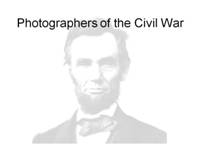 |
|
|
British Castles - Comfort's Triumph |
Castles came to Britain with the Norman Conquest. They served as defensible local seats of government and secure accommodation for the lords and their families.
By the time of Henry VIII, castles militarily irrelevant because of siege tactics and gunpowder. They were lacking in comfort and were frequently used as prisons rather than family lodgings.
The English Civil War briefly revived their military significance but after Parliament's victory, many castles were destroyed or sold for building materials.
Only a few remain occupied today - stately homes, such as Blenheim Palace, being used, in part, as accommodation for aristocratic families.
Numerous photographs and video clips will illustrate the rise and fall of Castles and how, today, they are used to provide 'atmosphere' for movies.
|
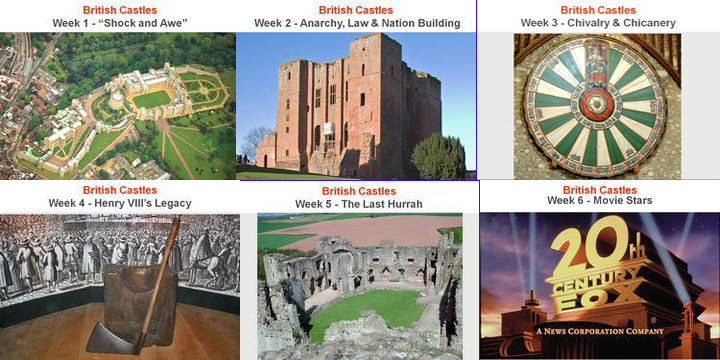 |
|
|
Monarchs of the Movies |
It is not easy being 'Royal' and English history provides many examples of Monarchs struggling with the job’s difficulties, ranging from providing a suitable heir to usurpation and murder. Movie scriptwriters have exploited this rich vein, often writing more for effect than accuracy. In this respect, they have followed William Shakespeare. He lived in dangerous times and was skilled at writing in a way that catered to royal sensitivities. His treatment of Richard III clearly pandered to the Tudors. And even though Macbeth, Hamlet and Lear were not English, their challenges were depicted in a way that seems deliberately intended to curry favor at the Royal Court. In addition to movies based on Shakespeare’s work, we will look at clips from a wide variety of others, showing English Royalty facing difficulty from Henry II to Elizabeth II.
References for rental of the movies discussed are provided.
|
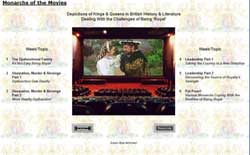 |
|
|
Reel Romans |
One of the problems with Ancient Rome's history is that much of it was written to promote a particular point of view. Emperor Augustus' swiftboating of Cleopatra is a clear example. And Romans clearly had the power of the pen when it came to shaping opinion about the Barbarians, who had no written language. Thanks to the Roman Catholic Church, a living relic of the Empire, the 'Roman' version of history has been preserved.
Together with the New Testament, Roman history has inspired many 'Roman' movies and the link between state and church is the program's unifying theme. While much of the history is rather grim, movie makers have been able to find humor in it, and this is not ignored.
References are provided for rental of the movies discussed.
|
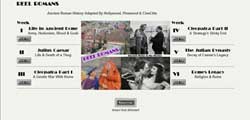 |
|
| English Medieval Cathedrals |
Cathedral building in England exploded after the Norman Conquest, which came with an order from the Pope to revive the Church there. Norman craftsmen were brought in to build a series of imposing cathedrals. With each one, the resident bishop strove to create a piece of Heaven on Earth in which to perform the mysteries of the Liturgy - and to glorify his status. For four centuries, until the Reformation brought things to an end, the Catholic Church in England prospered. Throughout this period, bishops continued to satisfy their ambitions with a series of major reconstructions of the existing cathedrals. The resulting mix of architectural styles, some being uniquely English, clearly differentiates those cathedrals from contemporaries in the rest of Europe. We will follow the development of this unique character and briefly explore how cathedrals may have contributed to the birth of English theatre and its style of humor. |
 |
|
English, The Language & History
An Exercise in Democracy |
The English language has a complex life story. It started as a ‘soup’ of immigrant dialects of Germanic origin, heavily seasoned with Latin. After the Norman Conquest, French became the language of government and English was left to fend for itself. The grammar became simplified as useful words from French and other languages were adopted. This unstructured development eventually helped to create a national identity.
After 1500 years, the development of English has grown beyond the boundaries of Britain. Thanks to its use in the USA, English has become the primary means of global communication for trade and diplomacy.
Visible traces of key stages in this evolution will be examined together with the related historical events. These events include invasions, disasters, social upheaval, acts of genius and the results of human frailty.
The format will be lecture and discussion, using video, audio and charts for illustration. The intention is to offer a narrative, not a detailed linguistic analysis.
|
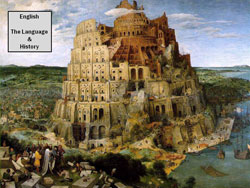 |
|
|
| |
